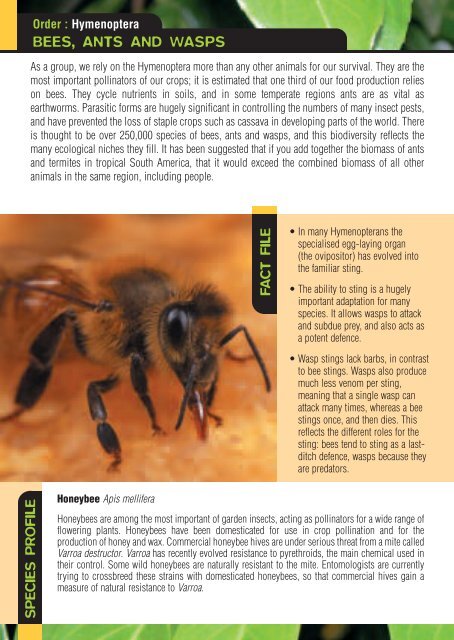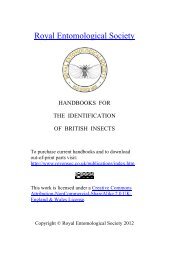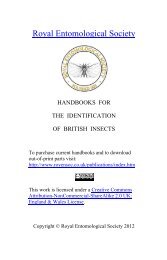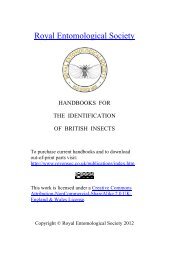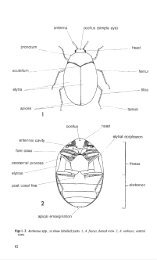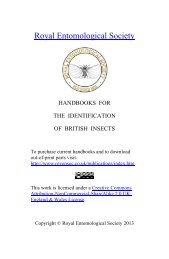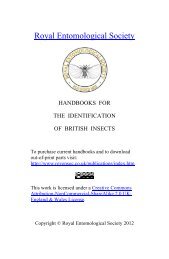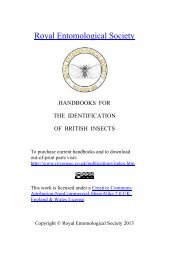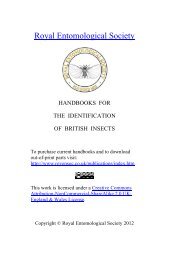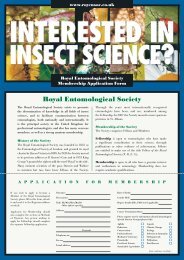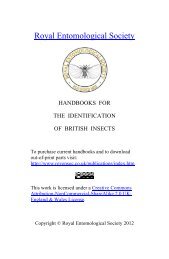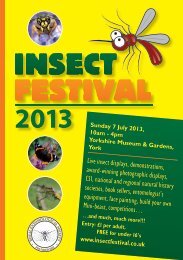Garden Entomology - Royal Entomological Society
Garden Entomology - Royal Entomological Society
Garden Entomology - Royal Entomological Society
You also want an ePaper? Increase the reach of your titles
YUMPU automatically turns print PDFs into web optimized ePapers that Google loves.
SPECIES PROFILE<br />
Order : Hymenoptera<br />
BEES, ANTS AND WASPS<br />
As a group, we rely on the Hymenoptera more than any other animals for our survival. They are the<br />
most important pollinators of our crops; it is estimated that one third of our food production relies<br />
on bees. They cycle nutrients in soils, and in some temperate regions ants are as vital as<br />
earthworms. Parasitic forms are hugely significant in controlling the numbers of many insect pests,<br />
and have prevented the loss of staple crops such as cassava in developing parts of the world. There<br />
is thought to be over 250,000 species of bees, ants and wasps, and this biodiversity reflects the<br />
many ecological niches they fill. It has been suggested that if you add together the biomass of ants<br />
and termites in tropical South America, that it would exceed the combined biomass of all other<br />
animals in the same region, including people.<br />
FACT FILE<br />
• In many Hymenopterans the<br />
specialised egg-laying organ<br />
(the ovipositor) has evolved into<br />
the familiar sting.<br />
• The ability to sting is a hugely<br />
important adaptation for many<br />
species. It allows wasps to attack<br />
and subdue prey, and also acts as<br />
a potent defence.<br />
• Wasp stings lack barbs, in contrast<br />
to bee stings. Wasps also produce<br />
much less venom per sting,<br />
meaning that a single wasp can<br />
attack many times, whereas a bee<br />
stings once, and then dies. This<br />
reflects the different roles for the<br />
sting: bees tend to sting as a lastditch<br />
defence, wasps because they<br />
are predators.<br />
Honeybee Apis mellifera<br />
Honeybees are among the most important of garden insects, acting as pollinators for a wide range of<br />
flowering plants. Honeybees have been domesticated for use in crop pollination and for the<br />
production of honey and wax. Commercial honeybee hives are under serious threat from a mite called<br />
Varroa destructor. Varroa has recently evolved resistance to pyrethroids, the main chemical used in<br />
their control. Some wild honeybees are naturally resistant to the mite. Entomologists are currently<br />
trying to crossbreed these strains with domesticated honeybees, so that commercial hives gain a<br />
measure of natural resistance to Varroa.


